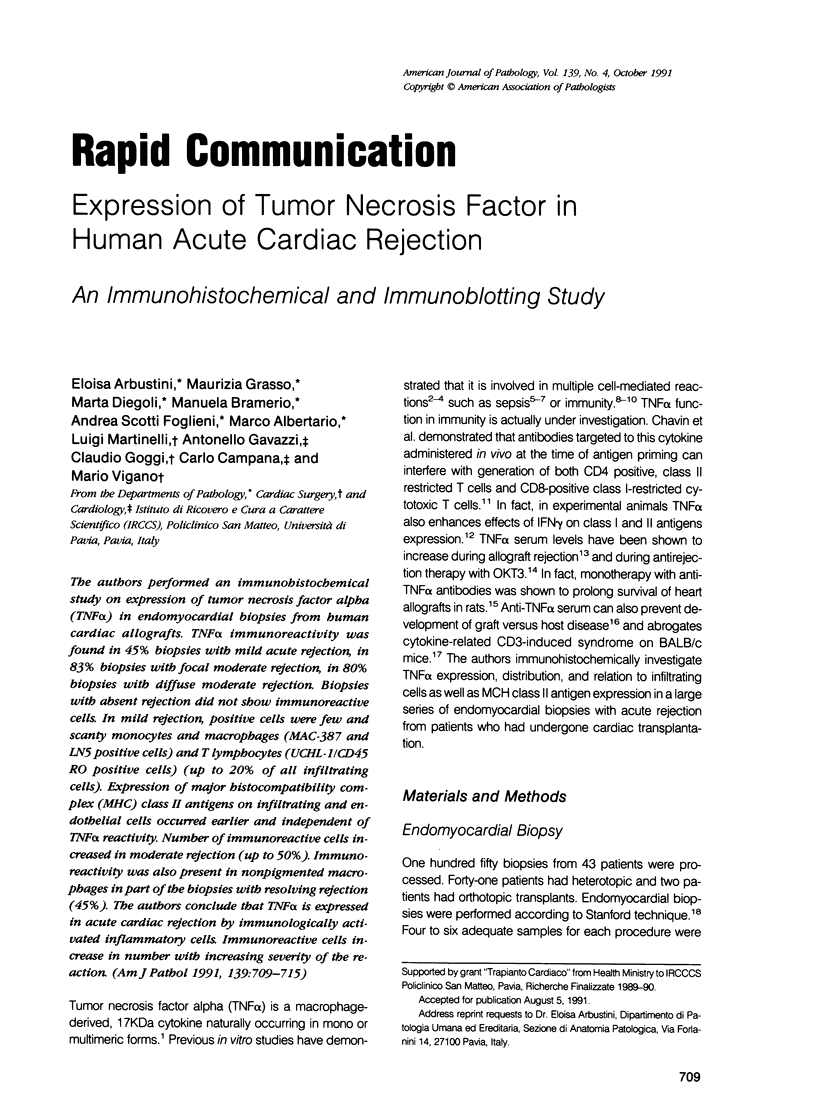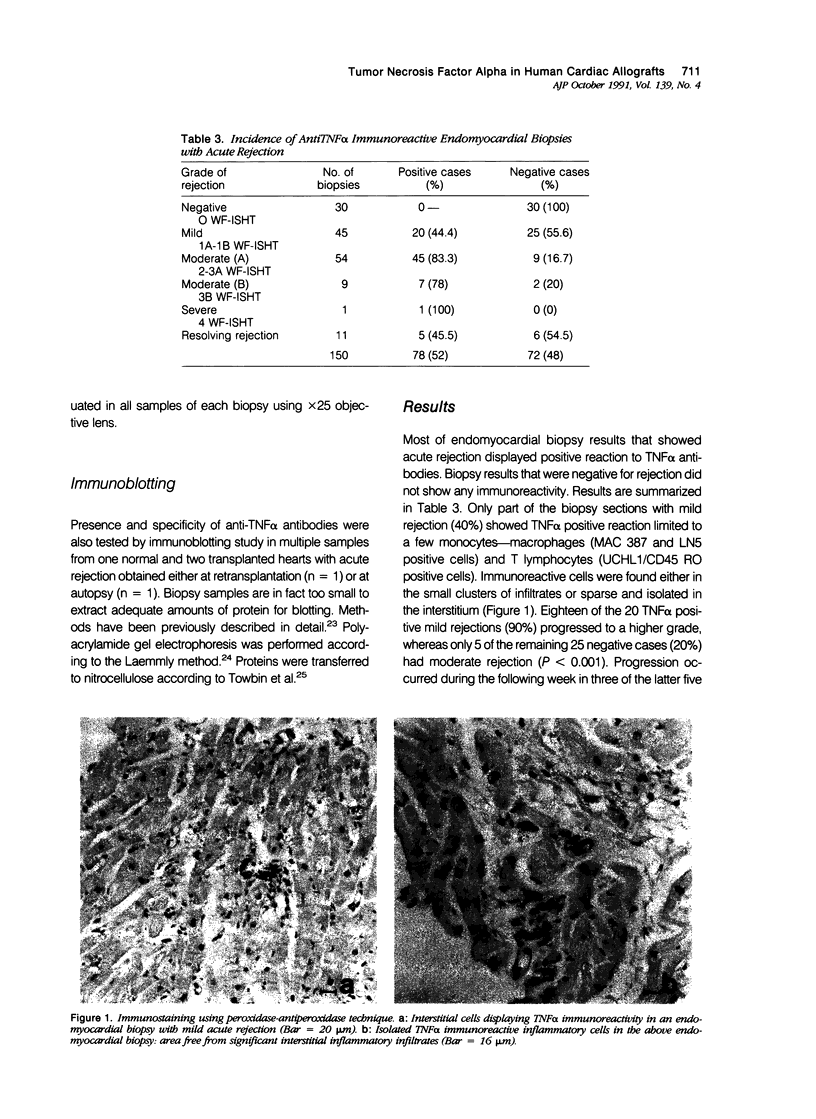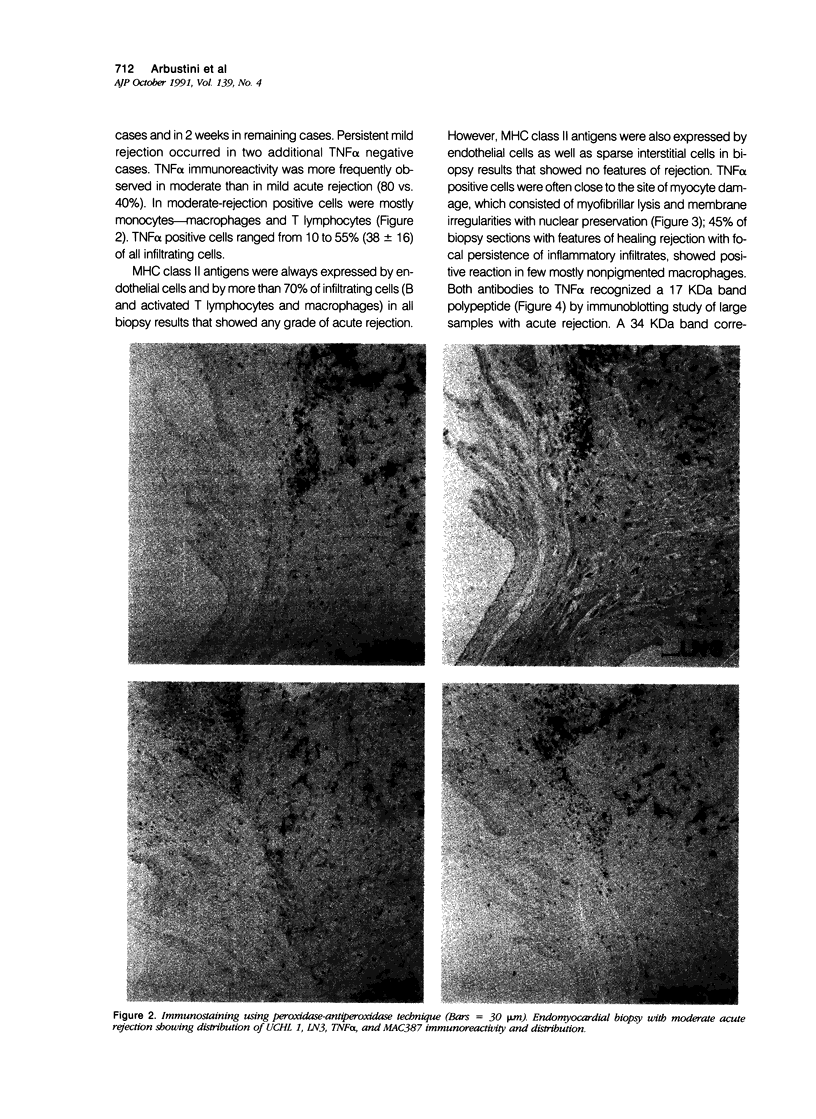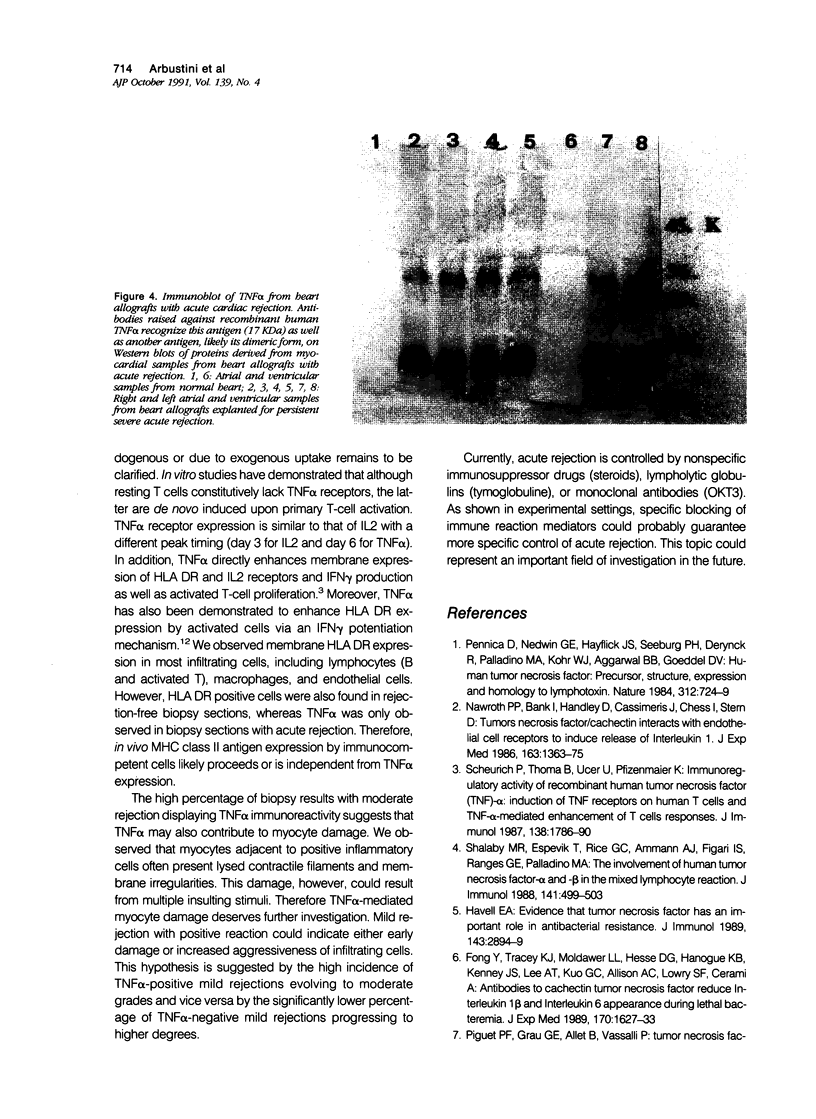Abstract
The authors performed an immunohistochemical study on expression of tumor necrosis factor alpha (TNFα) in endomyocardial biopsies from human cardiac allografts. TNFα immunoreactivity was found in 45% biopsies with mild acute rejection, in 83% biopsies with focal moderate rejection, in 80% biopsies with diffuse moderate rejection. Biopsies with absent rejection did not show immunoreactive cells. In mild rejection, positive cells were few and scanty monocytes and macrophages (MAC-387 and LN5 positive cells) and T lymphocytes (UCHL-1/CD45 RO positive cells) (up to 20% of all infiltrating cells). Expression of major histocompatibility complex (MHC) class II antigens on infiltrating and endothelial cells occurred earlier and independent of TNFα reactivity. Number of immunoreactive cells increased in moderate rejection (up to 50%). Immunoreactivity was also present in nonpigmented macrophages in part of the biopsies with resolving rejection (45%). The authors conclude that TNFα is expressed in acute cardiac rejection by immunologically activated inflammatory cells. Immunoreactive cells increase in number with increasing severity of the reaction.
Full text
PDF






Images in this article
Selected References
These references are in PubMed. This may not be the complete list of references from this article.
- Arbustini E., Pucci A., Grasso M., Diegoli M., Pozzi R., Gavazzi A., Graziano G., Campana C., Goggi C., Martinelli L. Expression of natriuretic peptide in ventricular myocardium of failing human hearts and its correlation with the severity of clinical and hemodynamic impairment. Am J Cardiol. 1990 Oct 15;66(12):973–980. doi: 10.1016/0002-9149(90)90936-u. [DOI] [PubMed] [Google Scholar]
- Bermudez L. E., Stevens P., Kolonoski P., Wu M., Young L. S. Treatment of experimental disseminated Mycobacterium avium complex infection in mice with recombinant IL-2 and tumor necrosis factor. J Immunol. 1989 Nov 1;143(9):2996–3000. [PubMed] [Google Scholar]
- Billingham M. E., Cary N. R., Hammond M. E., Kemnitz J., Marboe C., McCallister H. A., Snovar D. C., Winters G. L., Zerbe A. A working formulation for the standardization of nomenclature in the diagnosis of heart and lung rejection: Heart Rejection Study Group. The International Society for Heart Transplantation. J Heart Transplant. 1990 Nov-Dec;9(6):587–593. [PubMed] [Google Scholar]
- Caves P. K., Stinson E. B., Billingham M., Shumway N. E. Percutaneous transvenous endomyocardial biopsy in human heart recipients. Experience with a new technique. Ann Thorac Surg. 1973 Oct;16(4):325–336. doi: 10.1016/s0003-4975(10)65002-3. [DOI] [PubMed] [Google Scholar]
- Chatenoud L., Ferran C., Legendre C., Thouard I., Merite S., Reuter A., Gevaert Y., Kreis H., Franchimont P., Bach J. F. In vivo cell activation following OKT3 administration. Systemic cytokine release and modulation by corticosteroids. Transplantation. 1990 Apr;49(4):697–702. doi: 10.1097/00007890-199004000-00009. [DOI] [PubMed] [Google Scholar]
- Chavin K. D., Bromberg J. S., Kunkel S. L., Naji A., Barker C. F. Effects of a polyclonal anti-TNF antibody on cell-mediated immunity in vivo. Transplant Proc. 1991 Feb;23(1 Pt 1):847–848. [PubMed] [Google Scholar]
- Dinarello C. A., Cannon J. G., Wolff S. M., Bernheim H. A., Beutler B., Cerami A., Figari I. S., Palladino M. A., Jr, O'Connor J. V. Tumor necrosis factor (cachectin) is an endogenous pyrogen and induces production of interleukin 1. J Exp Med. 1986 Jun 1;163(6):1433–1450. doi: 10.1084/jem.163.6.1433. [DOI] [PMC free article] [PubMed] [Google Scholar]
- Ferran C., Sheehan K., Schreiber R., Bach J. F., Chatenoud L. Anti-TNF abrogates the cytokine-related anti-CD3 induced syndrome. Transplant Proc. 1991 Feb;23(1 Pt 1):849–850. [PubMed] [Google Scholar]
- Fong Y., Tracey K. J., Moldawer L. L., Hesse D. G., Manogue K. B., Kenney J. S., Lee A. T., Kuo G. C., Allison A. C., Lowry S. F. Antibodies to cachectin/tumor necrosis factor reduce interleukin 1 beta and interleukin 6 appearance during lethal bacteremia. J Exp Med. 1989 Nov 1;170(5):1627–1633. doi: 10.1084/jem.170.5.1627. [DOI] [PMC free article] [PubMed] [Google Scholar]
- Havell E. A. Evidence that tumor necrosis factor has an important role in antibacterial resistance. J Immunol. 1989 Nov 1;143(9):2894–2899. [PubMed] [Google Scholar]
- Hsu S. M., Raine L., Fanger H. Use of avidin-biotin-peroxidase complex (ABC) in immunoperoxidase techniques: a comparison between ABC and unlabeled antibody (PAP) procedures. J Histochem Cytochem. 1981 Apr;29(4):577–580. doi: 10.1177/29.4.6166661. [DOI] [PubMed] [Google Scholar]
- Laemmli U. K. Cleavage of structural proteins during the assembly of the head of bacteriophage T4. Nature. 1970 Aug 15;227(5259):680–685. doi: 10.1038/227680a0. [DOI] [PubMed] [Google Scholar]
- Leszczynski D. Interleukin-1 alpha inhibits the effects of gamma-interferon and tumor necrosis factor alpha on the expression of the major histocompatibility antigens by the rat endothelium. Am J Pathol. 1990 Jan;136(1):229–237. [PMC free article] [PubMed] [Google Scholar]
- Maury C. P., Teppo A. M. Raised serum levels of cachectin/tumor necrosis factor alpha in renal allograft rejection. J Exp Med. 1987 Oct 1;166(4):1132–1137. doi: 10.1084/jem.166.4.1132. [DOI] [PMC free article] [PubMed] [Google Scholar]
- Nawroth P. P., Bank I., Handley D., Cassimeris J., Chess L., Stern D. Tumor necrosis factor/cachectin interacts with endothelial cell receptors to induce release of interleukin 1. J Exp Med. 1986 Jun 1;163(6):1363–1375. doi: 10.1084/jem.163.6.1363. [DOI] [PMC free article] [PubMed] [Google Scholar]
- Pennica D., Nedwin G. E., Hayflick J. S., Seeburg P. H., Derynck R., Palladino M. A., Kohr W. J., Aggarwal B. B., Goeddel D. V. Human tumour necrosis factor: precursor structure, expression and homology to lymphotoxin. Nature. 1984 Dec 20;312(5996):724–729. doi: 10.1038/312724a0. [DOI] [PubMed] [Google Scholar]
- Scheringa M., de Bruin R. W., Jeekel H., Marquet R. L. Anti-tumor necrosis factor alpha serum prolongs heart allograft survival in rats. Transplant Proc. 1991 Feb;23(1 Pt 1):547–548. [PubMed] [Google Scholar]
- Scheurich P., Thoma B., Ucer U., Pfizenmaier K. Immunoregulatory activity of recombinant human tumor necrosis factor (TNF)-alpha: induction of TNF receptors on human T cells and TNF-alpha-mediated enhancement of T cell responses. J Immunol. 1987 Mar 15;138(6):1786–1790. [PubMed] [Google Scholar]
- Shalaby M. R., Espevik T., Rice G. C., Ammann A. J., Figari I. S., Ranges G. E., Palladino M. A., Jr The involvement of human tumor necrosis factors-alpha and -beta in the mixed lymphocyte reaction. J Immunol. 1988 Jul 15;141(2):499–503. [PubMed] [Google Scholar]
- Shalaby M. R., Fendly B., Sheehan K. C., Schreiber R. D., Ammann A. J. Prevention of the graft-versus-host reaction in newborn mice by antibodies to tumor necrosis factor-alpha. Transplantation. 1989 Jun;47(6):1057–1061. doi: 10.1097/00007890-198906000-00028. [DOI] [PubMed] [Google Scholar]
- Towbin H., Staehelin T., Gordon J. Electrophoretic transfer of proteins from polyacrylamide gels to nitrocellulose sheets: procedure and some applications. Proc Natl Acad Sci U S A. 1979 Sep;76(9):4350–4354. doi: 10.1073/pnas.76.9.4350. [DOI] [PMC free article] [PubMed] [Google Scholar]
- Waage A., Halstensen A., Shalaby R., Brandtzaeg P., Kierulf P., Espevik T. Local production of tumor necrosis factor alpha, interleukin 1, and interleukin 6 in meningococcal meningitis. Relation to the inflammatory response. J Exp Med. 1989 Dec 1;170(6):1859–1867. doi: 10.1084/jem.170.6.1859. [DOI] [PMC free article] [PubMed] [Google Scholar]






